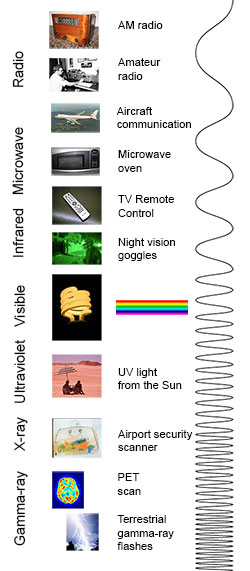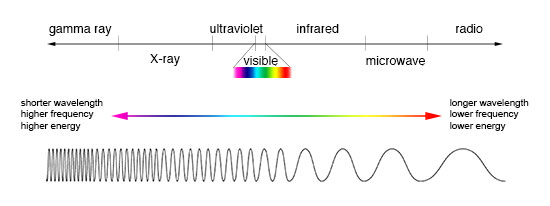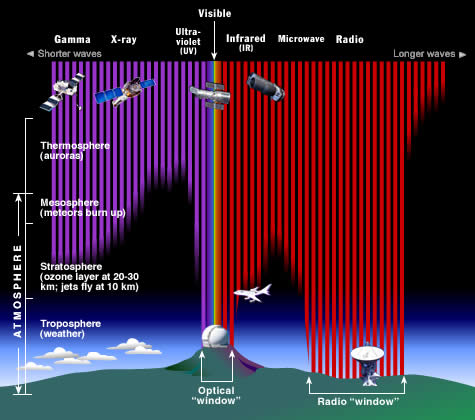as you move from left to right on the electromagnetic spectrum what happens to frequency
The Electromagnetic Spectrum
The electromagnetic (EM) spectrum is the range of all types of EM radiation. Radiation is energy that travels and spreads out as information technology goes – the visible light that comes from a lamp in your firm and the radio waves that come up from a radio station are two types of electromagnetic radiation. The other types of EM radiation that brand up the electromagnetic spectrum are microwaves, infrared calorie-free, ultraviolet light, X-rays and gamma-rays.
You know more almost the electromagnetic spectrum than you may think. The image below shows where you might come across each portion of the EM spectrum in your 24-hour interval-to-day life.

The electromagnetic spectrum from lowest energy/longest wavelength (at the top) to highest energy/shortest wavelength (at the lesser). (Credit: NASA'south Imagine the Universe)
Radio: Your radio captures radio waves emitted by radio stations, bringing your favorite tunes. Radio waves are likewise emitted by stars and gases in infinite.
Microwave: Microwave radiations will cook your popcorn in merely a few minutes, simply is likewise used by astronomers to learn about the structure of nearby galaxies.
Infrared: Night vision goggles pick up the infrared low-cal emitted past our skin and objects with heat. In space, infrared light helps us map the dust betwixt stars.
Visible: Our eyes detect visible light. Fireflies, light bulbs, and stars all emit visible light.
Ultraviolet: Ultraviolet radiation is emitted by the Dominicus and are the reason pare tans and burns. "Hot" objects in space emit UV radiation as well.
X-ray: A dentist uses X-rays to image your teeth, and drome security uses them to come across through your bag. Hot gases in the Universe too emit X-rays.
Gamma ray: Doctors use gamma-ray imaging to come across inside your body. The biggest gamma-ray generator of all is the Universe.
Is a radio wave the same as a gamma ray?
Are radio waves completely different concrete objects than gamma-rays? They are produced in different processes and are detected in unlike ways, but they are not fundamentally different. Radio waves, gamma-rays, visible light, and all the other parts of the electromagnetic spectrum are electromagnetic radiations.
Electromagnetic radiations tin can exist described in terms of a stream of mass-less particles, called photons, each traveling in a moving ridge-like blueprint at the speed of low-cal. Each photon contains a certain corporeality of energy. The dissimilar types of radiations are defined past the the amount of energy found in the photons. Radio waves have photons with depression energies, microwave photons take a little more free energy than radio waves, infrared photons have still more, then visible, ultraviolet, X-rays, and, the most energetic of all, gamma-rays.
Measuring electromagnetic radiations
Electromagnetic radiation can be expressed in terms of energy, wavelength, or frequency. Frequency is measured in cycles per second, or Hertz. Wavelength is measured in meters. Free energy is measured in electron volts. Each of these three quantities for describing EM radiation are related to each other in a precise mathematical way. Simply why take iii ways of describing things, each with a different gear up of physical units?

Comparison of wavelength, frequency and free energy for the electromagnetic spectrum. (Credit: NASA's Imagine the Universe)
The short answer is that scientists don't like to utilize numbers whatever bigger or smaller than they have to. It is much easier to say or write "two kilometers" than "two thousand meters." Generally, scientists apply whatsoever units are easiest for the blazon of EM radiation they piece of work with.
Astronomers who study radio waves tend to utilise wavelengths or frequencies. Most of the radio part of the EM spectrum falls in the range from about 1 cm to ane km, which is 30 gigahertz (GHz) to 300 kilohertz (kHz) in frequencies. The radio is a very wide function of the EM spectrum.
Infrared and optical astronomers generally use wavelength. Infrared astronomers use microns (millionths of a meter) for wavelengths, so their office of the EM spectrum falls in the range of 1 to 100 microns. Optical astronomers use both angstroms (0.00000001 cm, or
The wavelengths of ultraviolet, X-ray, and gamma-ray regions of the EM spectrum are very small. Instead of using wavelengths, astronomers that written report these portions of the EM spectrum commonly refer to these photons by their energies, measured in electron volts (eV). Ultraviolet radiation falls in the range from a few electron volts to about 100 eV. 10-ray photons have energies in the range 100 eV to 100,000 eV (or 100 keV). Gamma-rays then are all the photons with energies greater than 100 keV.
![]() Show me a nautical chart of the wavelength, frequency, and energy regimes of the spectrum
Show me a nautical chart of the wavelength, frequency, and energy regimes of the spectrum
Why do nosotros put telescopes in orbit?

The Globe's atmosphere stops almost types of electromagnetic radiations from infinite from reaching Globe's surface. This illustration shows how far into the temper different parts of the EM spectrum tin go before being captivated. Just portions of radio and visible low-cal accomplish the surface. (Credit: STScI/JHU/NASA)
Well-nigh electromagnetic radiation from space is unable to reach the surface of the Earth. Radio frequencies, visible light and some ultraviolet light makes it to body of water level. Astronomers can discover some infrared wavelengths by putting telescopes on mount tops. Airship experiments can reach 35 km above the surface and can operate for months. Rocket flights tin take instruments all the way above the Earth'southward atmosphere, but but for a few minutes earlier they fall back to Earth.
For long-term observations, however, it is all-time to have your detector on an orbiting satellite and become above information technology all!
Updated: March 2013
Source: https://imagine.gsfc.nasa.gov/science/toolbox/emspectrum1.html
0 Response to "as you move from left to right on the electromagnetic spectrum what happens to frequency"
Post a Comment